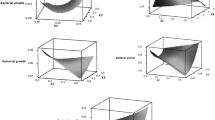Abstract
A strain of Pseudomonas putida (biotype A) capable of growing on caffeine (1,3,7-trimethylxanthine) was isolated from a domestic wastewater processing operation. It used caffeine as the sole carbon source with a mean growth rate constant (k) of 0.049 h-1 (approximately 20 h per generation), whereas k for glucose utilization under similar incubation conditions was 0.31 (3.3 h per generation). The isolate contained at least two plasmids, and the increased expression of a 40 kDa protein was attributable to growth on caffeine. Degradation byproducts of caffeine metabolism by the bacterial isolate included other xanthine derivatives. The slow bacterial catabolism of caffeine in sewage has implications for the effectiveness of wastewater purification, re-use and disposal.
Similar content being viewed by others
References
AldersonT. & KhanA.H. 1967 Caffeine-induced mutagenesis in Drosophila. Nature 215, 1080–1081.
AndersonD.G. & McKayL.L. 1983 Simple and rapid method for isolating large plasmid DNA from lactic streptococci. Applied and Environmental Microbiology 46, 549–552.
ArnaudM.J. 1993 Metabolism of caffeine and other components of coffee. In Caffeine, Coffee, and Health, ed. GarattiniS. pp. 43–95. New York: Raven Press.
BattigK. & WelzlH. 1993 Psychopharmacological profile of caffeine. In Caffeine, Coffee, and Health, ed GarattiniS. pp 213–253. New York: Raven Press.
BaroneJ.J. RobertsH. 1984 Human consumption of caffeine. In Caffeine, ed DewsP.B. pp. 59–73. New York: Springer-Verlag.
BerthouF., FlinoisJ.-P., RatanasavanhD., BeauneP., RicheC. & GuillouzoA. 1991 Evidence for the involvement of several cytochromes P-450 in the first steps of caffeine metabolism by human liver microsomes. Drug Metabolism and Disposition. 19, 561–567.
DalyJ.B. 1993 Mechanism of action of caffeine. In Caffeine, Coffee, and Health. ed GarattiniS. p. 97. New York: Raven Press.
EatonA.D., ClesceriL.S. & GreenbergA.E. 1995 Standard Methods for the Examination of Water and Wastewater (19th Edition). Part 9000. Washington, DC: American Public Health Association.
GarrisonA.W., PopeJ.D. & AllenF.R. 1977 GC/MS Analysis of Organic Compounds in Domestic Wasterwater. In Identification and Analysis of Organic Pollutants in Water. ed KeithL.H. pp. 517–556. Ann Arbor: Ann Arbor Science.
GrahamD.M. 1978 Caffeine: its identity, dietary sources, intake and biological effects. Nutrition Review 36, 97–102.
HormanI. & VianiR. 1972 The nature and conformation of the caffeine-chlorogenate complex of coffee. Journal of Food Science 37, 925–927.
HurstJ.W., MartinR.A. & TarkaS.M. 1984 Analytical methods for quantitation of methylxanthines. In The Methylxanthine Beverages and Foods: Chemistry, Consumption, and Health Effects. ed SpillerG.A. pp. 17–28. New York: Alan R. Liss, Inc.
JamesJ.E. 1991 Caffeine and Health. p. 42–57. San Diego: Academic Press.
KatzS.N. 1984 Decaffeination of coffee. In Coffee and Health. ed MacmahonB. & SugimuraT., Banbury Report 17, 11–20. New York: Cold Spring Harbor Laboratory.
KihlmanB.A. 1974 Effects of caffeine on the genetic material. Mutation Research 26, 53–71.
KihlmanB.A. 1977 Caffeine and Chromosomes p. 249. New York: Elsevier.
KrebsK.G., HeusserD. & WimmerH. 1969 Spray Reagents. In Thin-Layer Chromatography. ed StahlE. p.854. New York: Springer-Verlag.
KurtzmanR.H. & SchwimmerS. 1971 Caffeine removal from growth media by microorganisms. Experientia 27, 481–482.
MarksV. & KellyJ.F. 1973 Absorption of caffeine from tea, coffee, and cocacola. Lancet 1, 827.
MohrU., EmuraM. & Riebe-ImreM. 1993 Experimental studies on carcinogenicity and mutagenicity of caffeine. In Caffeine, Coffee, and Health. ed GarattiniS. pp. 359–378 New York: Raven Press.
OgunseitanO.A. & OlsonB.H. 1993 Effect of 2-hydroxybenzoate on the rate of naphthalene mineralization in soil. Applied Microbiology and Biotechnology 38, 799–807.
PurvesD. & SullivanF.M. 1993 Reproductive effects of caffeine. In Caffeine, Coffee, and Health. ed GarattiniS. pp. 317–342. New York: Raven Press.
SambrookJ., FritschE. & ManiatisT. 1989 Molecular Cloning. Cold Spring Harbor, New York: Cold Spring Harbor Laboratory Press.
SingleyJ.E., KirchmerC.J. & MiuraR. 1974 Analysis of Coprostanol, an Indicator of Fecal Contamination. Environmental Protection Technology Series. EPA-660/2-74-021. Washington, DC; U.S. Environmental Protection Agency.
SturelidS. & KihlmanB.A. 1975 Enhancement by methylated oxypurines of the frequency of induced chromosomal aberrations. I. The dependence of the effect of the molecular structure of the potentiating agent. Hereditas 79, 29–42.
SuzukiT. & TakahashiF. 1975 Biosynthesis of caffeine by tea-leaf extracts. Enzymic formation of theobromine from 7-methylxanthine and of caffeine from theobromine. Biochemical Journal 146,87–96.
WillamanJ.J. & SchubertB.G. 1961 Alkaloid-bearing plants and their contained alkaloids. Agricultural Research Services, United States Department of Agriculture Technical Bulletin 1234, 1–287.
WoolfolkC.A. 1975 Metabolism of N-methylpurines by a Pseudomonas putida strain isolated by enrichment on caffeine as the sole carbon source of carbon and nitrogen. Journal of Bacteriology 123, 1088–1106.
Additional information
The author is with the Laboratory for Molecular Ecology, Department of Environmental Analysis and Design, University of California at Irvine, Irvine, CA 92717-5150 U.S.A.
Rights and permissions
About this article
Cite this article
Ogunseitan, O.A. Removal of caffeine in sewage by Pseudomonas putida: Implications for water pollution index. World Journal of Microbiology & Biotechnology 12, 251–256 (1996). https://doi.org/10.1007/BF00360923
Revised:
Accepted:
Issue Date:
DOI: https://doi.org/10.1007/BF00360923




